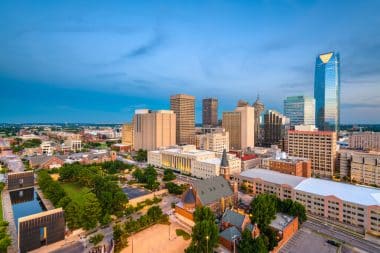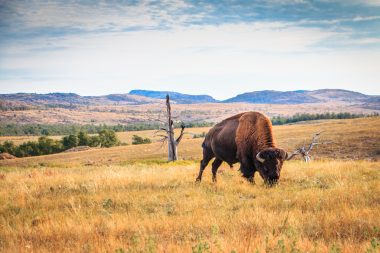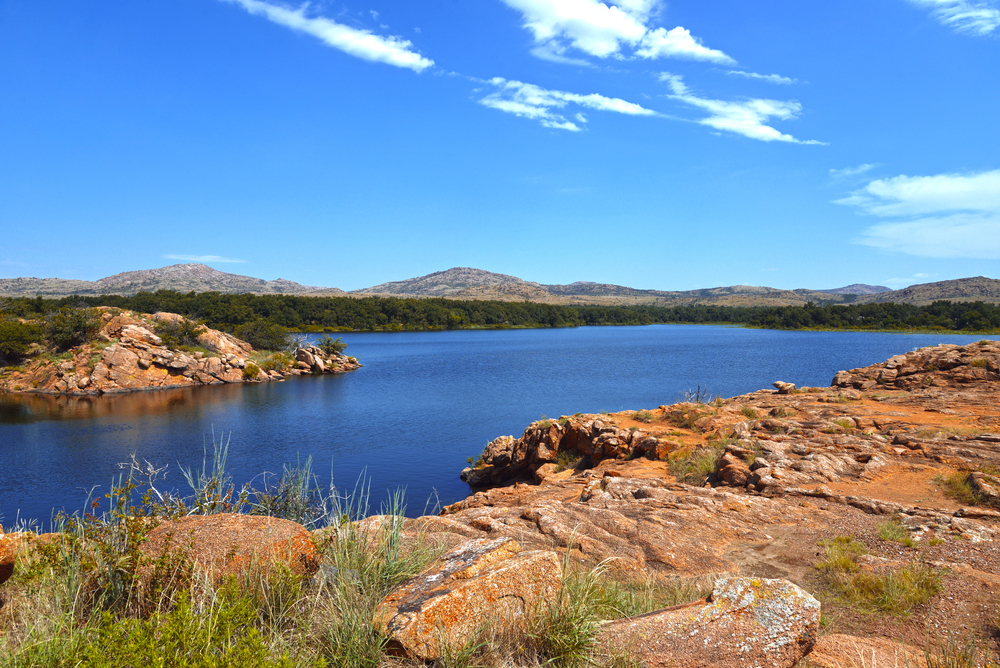Yes, the buffalo still roam, albeit sporadically, through the prairies and hills of Oklahoma. In fact, they are a big highlight for anyone who wants to explore the surprisingly beautiful natural landscape in the east of the American state. Culturally, Oklahoma is the epitome of a destination for people who have a soft spot for cowboys and Indians or the Wild West. Both play a huge role in Oklahoma’s social fabric and the history of both were among the highlights of any visit to the state of the buffalo.
Oklahoma City and Tulsa

There are few urban attractions in Oklahoma, but fortunately, they are conveniently located around Oklahoma City and Tulsa. The two cities are former cattle drover towns and offer many worthwhile sights for tourists. They offer great Western cuisine and many fun attractions for young and old, such as zoos, art museums and historical sites. In the excellent cultural centers of Oklahoma City, you can learn a lot about the origins of the American cowboys and the sometimes very sad history of the Native Americans. Oklahoma is still home to about 40 indigenous tribes who speak 25 different languages.
Mentality of the Sooners
Most Oklahomans, or Sooners as they prefer to be called, are laid-back, authentic people who are sometimes a bit suspicious of strangers. The Western look and feel of this American state can be felt at every turn, but that’s also a big part of its appeal. While luxurious resorts and restaurants are rare, comfortable hotels and long-established diners are well represented along historic Route 66. Oklahoma is very affordable in terms of price and therefore attracts many tourists in this price segment.
Pure nature

In the eastern part of the state, a truly impressive nature awaits. Four mountain ranges fill the flat prairie country with rolling forested hills and plenty of wildlife. You can drive one of America’s most scenic roads on the Talimena Scenic Byway , or immerse yourself in nature at the Wichita Mountains Wildlife Reserve, where bison still roam freely. There are also some beautiful lakes in Oklahoma that are worth a visit: Lake Hefner was built in 1947 and is considered the first address for sailboating in Oklahoma City. In addition to fishing, picnicking and golfing, Lake Hefner is also known for its great outdoor recreation value. Hiking trails run around the entire lake and extend for a total of just over 14 kilometers. Built in the early 1960s as a municipal water reservoir, Lake Thunderbird is a popular spot in town for boating, fishing, biking, and other outdoor recreational activities. It consists of 6,070 hectares and includes more than 80 miles of shoreline. The short drive from Oklahoma City is well worth it when you consider all the lake has to offer.
However, without your own vehicle, it’s unlikely that you’ll get to see much in Oklahoma. Attractions are often located outside the city, and the cities are far from each other. Driving in Oklahoma is actually a highlight, because the streets are flat and mostly empty. By car, you can visit unique places like the Trail of Tears, where so many Native Americans have experienced suffering, death and misery while relocating to a reservation, or look for bison in the game reserve. Even better, take a long drive along Route 66 and diner-hop for classic All-American food and dessert.
Highlights in Oklahoma
- Keep an eye out for wild bison at Wichita National Wildlife Reserve as you drive through one of the most beautiful areas in the state
- Learn about Native American and cowboy culture at the fascinating National Cowboy & Western Heritage Museum
- Drive along the legendary Route 66 for a few days, stopping at old diners for dining and cool old-school motels for sleeping
- Pick up a new cowboy hat and a pair of boots at iconic Western stores like Langston’s in Oklahoma City
- Try your luck at one of the 70 casinos on the state’s Indian reservations
- Spend a night in the Blue Dome District in Tulsa, one of America’s coolest places to eat and drink
- Check out Oklahoma City’s renovated warehouse district, Bricktown, a hip spot with trendy bars after a meal at the legendary Cattlemen’s Steakhouse or the neighborhood’s myriad restaurants
- At Robbers Cave State Park , you can pretend you’re in Jesse James’ gang of outlaws.
Information about Oklohoma
- Foundation: Oklahoma was officially admitted to the Union on November 16, 1907 as the 46th state. The name “Oklahoma” comes from the Choctaw language and means “Red People”.
- Indian Tribal Land: Oklahoma is often referred to as “Indian Tribes Country” because it is home to many indigenous peoples. Prior to settlement by European settlers in the 19th century, it was home to numerous tribes, including the Cherokee, Choctaw, Chickasaw, Creek, and Seminoles.
- Trail of Tears: Oklahoma played a tragic role in the history of Native Americans in the United States. During the Trail of Tears, many indigenous peoples were expelled from their ancestral territories in the southeastern United States and forcibly relocated to Oklahoma.
- Oil industry: Oklahoma has a long history in the oil industry and was once a leading oil producer in the United States. The discovery of large oil deposits in the early 20th century contributed to the economic development of the state and led to the emergence of cities such as Tulsa and Oklahoma City.
- Tornado Alley: Oklahoma is located in the so-called “Tornado Alley”, a region in the central USA that is often hit by severe storms and tornadoes. Oklahoma is known for its turbulent weather conditions and experiences a significant number of tornadoes each year.
- Cultural diversity: Oklahoma is characterized by a diverse cultural landscape that reflects the traditions of Native American peoples, Wild West pioneers, and the African-American community. The state hosts a number of cultural events, festivals, and museums that celebrate this diversity.
- Sports: Sports are very important in Oklahoma, especially college football and basketball. The University of Oklahoma and Oklahoma State University have successful athletic programs and have loyal fan communities throughout the state.
The largest cities
- Oklahoma City: Oklahoma City is the capital of the state and also the largest city. With an estimated population of over 650,000, it is the economic and cultural center of Oklahoma. The city is also home to a variety of attractions, including the Oklahoma City National Memorial & Museum and the Bricktown Entertainment District.
- Tulsa: Tulsa is the second largest city in Oklahoma with a population of more than 400,000 people. The city has a rich history in the oil industry and is now an important center for energy companies. Tulsa is also known for its cultural institutions such as the Philbrook Museum of Art and the Tulsa Performing Arts Center.
- Norman: Norman is the third largest city in Oklahoma with a population of over 125,000. It is home to the University of Oklahoma and has a vibrant university culture. Norman is also known for its green parks, including Lake Thunderbird State Park and Fred Jones Jr. Museum of Art.
- Broken Arrow: Broken Arrow is a suburb of Tulsa and the fourth largest city in Oklahoma with a population of more than 110,000. The city has a fast-growing population and a strong economy characterized by industries such as aerospace, healthcare, and retail.
- Lawton: Lawton is the fifth largest city in Oklahoma with a population of over 90,000. The city is located in the southwest of the state and is known for its proximity to the Fort Sill Military Reservation and the Wichita Mountains Wildlife Refuge.


